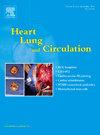心脏手术中抗精神病药物的使用:患病率、轨迹、危险因素和结果。
IF 2.2
4区 医学
Q2 CARDIAC & CARDIOVASCULAR SYSTEMS
引用次数: 0
摘要
背景:接受心脏手术的患者存在术后谵妄和抗精神病药物治疗的风险。然而,与这些治疗相关的患病率、危险因素和结果仍不清楚。方法:我们使用电子数据库对2012年至2021年间接受心脏手术的患者进行回顾性研究。我们获得了APMs使用的数据。我们使用基数匹配来确定与术后APM治疗相关的患者和手术特征,并研究APM治疗是否与预后相关。结果:我们研究了3188例患者。其中,13.6%(433/ 3188)接受了喹硫平(85.0%)、氟哌啶醇(41.1%)、奥氮平(22.2%)或利培酮(2.1%)形式的APMs。APM治疗的中位持续时间为3天,中位每日剂量为2.5 mg奥氮平当量,最常见的是在拔管后第2天(四分位数范围为1.7-3.9),在重症监护病房(ICU)出院前首次给药。氟哌啶醇的使用在研究期间有所减少。基数匹配显示体外循环时间延长、机械通气时间延长、ICU住院时间延长和术后急性肾损伤与APM治疗相关。配对后,APM组与对照组的死亡率无差异(绝对风险降低率[aRR] 0.94;95%置信区间[CI] 0.46-1.89;p=0.85)或再入院率(aRR 0.95;95% ci 0.74-1.20;p = 0.66)。然而,APM治疗与出院到非家庭目的地相关(aRR 1.39;95% ci 1.11-1.66;结论:APM治疗在心脏手术患者中较为常见。APM治疗平均3天。危险因素包括较长的体外循环和通气时间、较长的ICU住院时间和急性肾损伤。APM治疗与死亡率和再入院率无关。然而,这与减少对家庭的排放有关。出院时和6个月后的处方是罕见的。本文章由计算机程序翻译,如有差异,请以英文原文为准。
The Use of Antipsychotic Medications in Cardiac Surgery: Prevalence, Trajectory, Risk Factors and Outcomes
Background
Patients undergoing cardiac surgery are at risk for postoperative delirium and antipsychotic medication (APM) therapy. However, the prevalence, risk factors, and outcomes associated with these therapies remain unclear.
Methods
We retrospectively studied patients who underwent cardiac surgery between 2012 and 2021 using electronic databases. We obtained data on the use of APMs. We used cardinality matching to identify the patient and surgical characteristics associated with postoperative APM therapy and to study whether APM therapy was associated with outcomes.
Results
We studied 3,188 patients. Of these, 13.6% (433/3,188) received APMs in the form of quetiapine (85.0%), haloperidol (41.1%), olanzapine (22.2%), or risperidone (2.1%). APM therapy lasted a median of 3 days at a median daily dose of 2.5 mg olanzapine equivalents, most commonly first administered on day 2 (interquartile range 1.7–3.9), after extubation, and before discharge from the intensive care unit (ICU). Haloperidol use decreased during the study period. Cardinality matching revealed that longer cardiopulmonary bypass time, mechanical ventilation, longer ICU stay, and postoperative acute kidney injury were associated with APM therapy. After matching, there was no difference between APM and control patients for mortality (absolute risk reduction [aRR] 0.94; 95% confidence interval [CI] 0.46–1.89; p=0.85) or hospital readmission rates (aRR 0.95; 95% CI 0.74–1.20; p=0.66). APM therapy, however, was associated with discharge to a destination other than home (aRR 1.39; 95% CI 1.11–1.66; p<0.001). Only a minority (12.4%) of those who received postoperative APM received further prescriptions upon discharge.
Conclusions
APM therapy was common in cardiac surgery patients. APM therapy was an average of 3 days. The risk factors included longer cardiopulmonary bypass and ventilation, longer ICU stay, and acute kidney injury. APM therapy was not associated with mortality or hospital readmission. However, this was associated with decreased discharge to the home. Prescriptions upon discharge and at the 6 months following were rare.
求助全文
通过发布文献求助,成功后即可免费获取论文全文。
去求助
来源期刊

Heart, Lung and Circulation
CARDIAC & CARDIOVASCULAR SYSTEMS-
CiteScore
4.50
自引率
3.80%
发文量
912
审稿时长
11.9 weeks
期刊介绍:
Heart, Lung and Circulation publishes articles integrating clinical and research activities in the fields of basic cardiovascular science, clinical cardiology and cardiac surgery, with a focus on emerging issues in cardiovascular disease. The journal promotes multidisciplinary dialogue between cardiologists, cardiothoracic surgeons, cardio-pulmonary physicians and cardiovascular scientists.
 求助内容:
求助内容: 应助结果提醒方式:
应助结果提醒方式:


